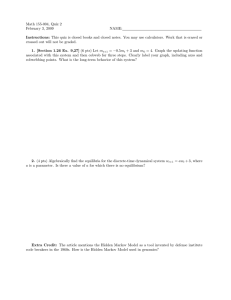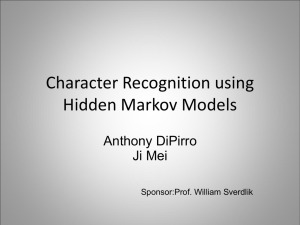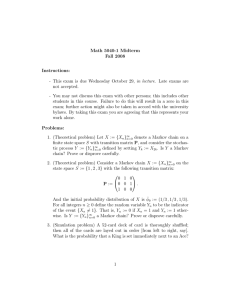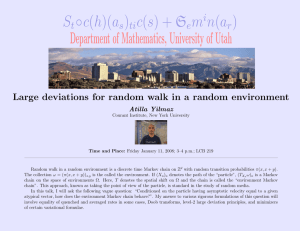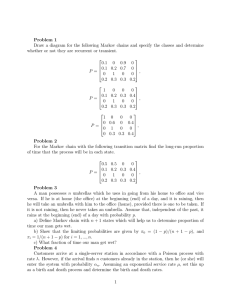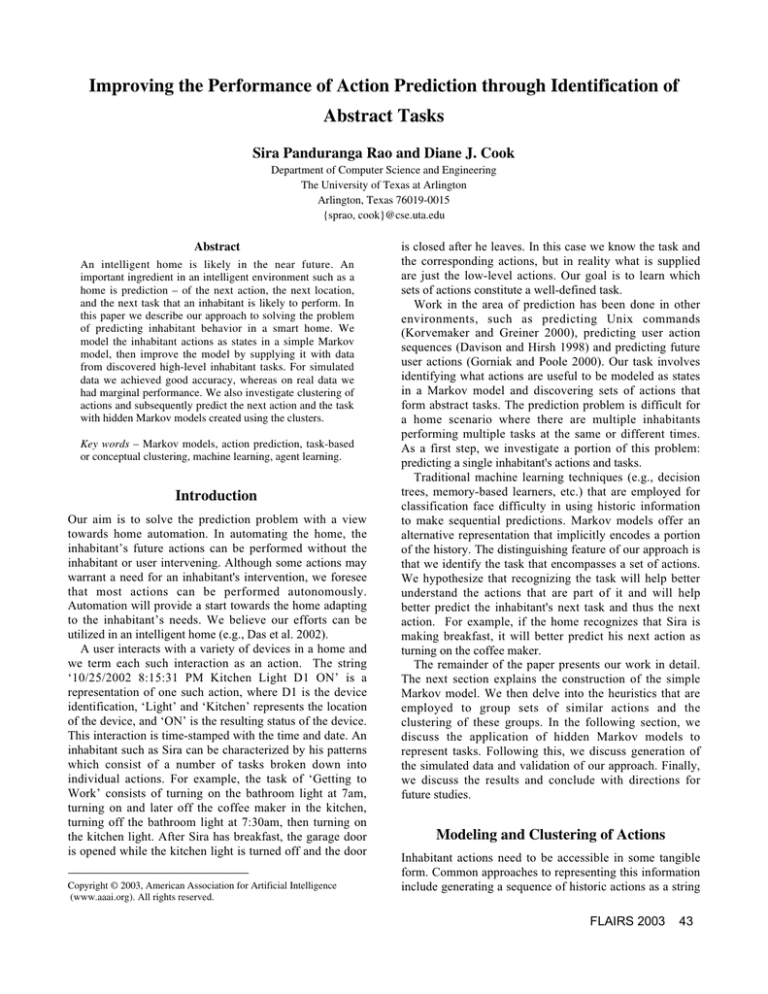
Improving the Performance of Action Prediction through Identification of
Abstract Tasks
Sira Panduranga Rao and Diane J. Cook
Department of Computer Science and Engineering
The University of Texas at Arlington
Arlington, Texas 76019-0015
{sprao, cook}@cse.uta.edu
Abstract
An intelligent home is likely in the near future. An
important ingredient in an intelligent environment such as a
home is prediction – of the next action, the next location,
and the next task that an inhabitant is likely to perform. In
this paper we describe our approach to solving the problem
of predicting inhabitant behavior in a smart home. We
model the inhabitant actions as states in a simple Markov
model, then improve the model by supplying it with data
from discovered high-level inhabitant tasks. For simulated
data we achieved good accuracy, whereas on real data we
had marginal performance. We also investigate clustering of
actions and subsequently predict the next action and the task
with hidden Markov models created using the clusters.
Key words – Markov models, action prediction, task-based
or conceptual clustering, machine learning, agent learning.
Introduction
Our aim is to solve the prediction problem with a view
towards home automation. In automating the home, the
inhabitant’s future actions can be performed without the
inhabitant or user intervening. Although some actions may
warrant a need for an inhabitant's intervention, we foresee
that most actions can be performed autonomously.
Automation will provide a start towards the home adapting
to the inhabitant’s needs. We believe our efforts can be
utilized in an intelligent home (e.g., Das et al. 2002).
A user interacts with a variety of devices in a home and
we term each such interaction as an action. The string
‘10/25/2002 8:15:31 PM Kitchen Light D1 ON’ is a
representation of one such action, where D1 is the device
identification, ‘Light’ and ‘Kitchen’ represents the location
of the device, and ‘ON’ is the resulting status of the device.
This interaction is time-stamped with the time and date. An
inhabitant such as Sira can be characterized by his patterns
which consist of a number of tasks broken down into
individual actions. For example, the task of ‘Getting to
Work’ consists of turning on the bathroom light at 7am,
turning on and later off the coffee maker in the kitchen,
turning off the bathroom light at 7:30am, then turning on
the kitchen light. After Sira has breakfast, the garage door
is opened while the kitchen light is turned off and the door
Copyright © 2003, American Association for Artificial Intelligence
(www.aaai.org). All rights reserved.
is closed after he leaves. In this case we know the task and
the corresponding actions, but in reality what is supplied
are just the low-level actions. Our goal is to learn which
sets of actions constitute a well-defined task.
Work in the area of prediction has been done in other
environments, such as predicting Unix commands
(Korvemaker and Greiner 2000), predicting user action
sequences (Davison and Hirsh 1998) and predicting future
user actions (Gorniak and Poole 2000). Our task involves
identifying what actions are useful to be modeled as states
in a Markov model and discovering sets of actions that
form abstract tasks. The prediction problem is difficult for
a home scenario where there are multiple inhabitants
performing multiple tasks at the same or different times.
As a first step, we investigate a portion of this problem:
predicting a single inhabitant's actions and tasks.
Traditional machine learning techniques (e.g., decision
trees, memory-based learners, etc.) that are employed for
classification face difficulty in using historic information
to make sequential predictions. Markov models offer an
alternative representation that implicitly encodes a portion
of the history. The distinguishing feature of our approach is
that we identify the task that encompasses a set of actions.
We hypothesize that recognizing the task will help better
understand the actions that are part of it and will help
better predict the inhabitant's next task and thus the next
action. For example, if the home recognizes that Sira is
making breakfast, it will better predict his next action as
turning on the coffee maker.
The remainder of the paper presents our work in detail.
The next section explains the construction of the simple
Markov model. We then delve into the heuristics that are
employed to group sets of similar actions and the
clustering of these groups. In the following section, we
discuss the application of hidden Markov models to
represent tasks. Following this, we discuss generation of
the simulated data and validation of our approach. Finally,
we discuss the results and conclude with directions for
future studies.
Modeling and Clustering of Actions
Inhabitant actions need to be accessible in some tangible
form. Common approaches to representing this information
include generating a sequence of historic actions as a string
FLAIRS 2003
43
of action symbols and representing individual actions as
separate states with corresponding state transitions. We
adopt the latter approach in this work.
Markov model of actions
Our motivation to approach the prediction problem within
the framework of Markov models is prompted by the need
to learn the pattern of user actions without remembering
large amounts of history. We model the entire sequence of
inhabitant actions as a simple Markov model, where each
state corresponds to one or more actions. For example,
consider the action A1: 10/25/2002 8:15:31 PM Kitchen
Light D1 ON which can be represented as a state in the
model. We construct smaller models by discretizing the
time of the action and neglecting the date. Consider
another action A2: 10/28/2002 8:11:46 PM Kitchen Light
D1 ON. The actions are composed of fields that we
represent as features in our state representation: date, time,
location, device description (e.g., LIGHT), device id, and
device status (e.g., ON). Observe that A1 and A2 differ only
in the time and date features. If the time difference
between the actions is minimal, the corresponding states
can be merged.
When each new action Ai is processed, a check is made
to see if the action is close enough to an existing model
state to merge with that state. An action is close enough to
an existing model state given that they both refer to the
same device and location but differ in the time and this
time difference is insignificant. If not, a new state is
created with action representative Ai and transitions are
created from the previous action in the sequence to Ai.
The values of each transition reflect the relative frequency
of the transition. Thus, discretizing helps achieve a
moderate number of states while increasing state transition
probabilities. If each action were to be considered as a
single state, there would be a great number of states giving
us no scope to come up with a good prediction approach.
Heuristics to Partition Actions
Based on the initial Markov model, a prediction can be
generated by matching the current state with a state in the
model and predicting the action that corresponds to the
outgoing transition from that state with the greatest
probability. We hypothesize that the predictive accuracy
can be improved by incorporating abstract task information
into the model. If we can identify the actions that comprise
a task, then we can identify the current task and generate
more accurate transition probabilities for the corresponding
task.
Actions in smart home log data are not labeled with the
corresponding high-level task, so we propose to discover
these tasks using unsupervised learning. The first step is to
partition the action sequence into subsequences that are
likely to be part of the same task. Given actions A1, A2, …,
AN we can divide these into groups G1, G2, …, GP, where
each group consists of a set of actions AI, …, AI+J and for
simplicity every action is part of only one group.
44
FLAIRS 2003
We separate an action sequence Ax, …, Ay into groups
Ax, …, Az and Az+1, …, Ay if at least one of the following
conditions holds:
1) The time difference between Az and Az+1 is > 90
minutes.
2) There is a difference in location between the Az
and Az+1.
3) The number of devices in the group is > 15.
The result of the partitioning step is a set of groups, or
individual tasks, that are ready to be clustered into sets of
similar tasks.
Clustering Partitions into Abstract Tasks
Given the different groups from the partitioning process,
we have to cluster similar groups together to form abstract
task classes. As a first step, we extract meta-features
describing the group as a whole. Information that we can
collect from each group includes the number of actions in
the group, the starting time and time duration of this group,
the locations visited and devices acted upon in the group.
This information is stored as a partition PI and thus we
have partitions P1, P2 , …, PP . The partitions are now
supplied to the clustering algorithm.
Clustering is used to group instances that are similar to
each other and the individual cluster represents an abstract
task definition. A cluster consists of these similar instances
and we can consider the mean of the cluster distribution as
the cluster representative, while the variance represents the
disparity in the grouping of the cluster instances. Because
we require clusters that group similar instances and
because of the inherent simplicity of the partitional
clustering algorithms, we apply k-means clustering to
partitions P1, P2, …, PP.
To perform clustering, we utilize LNKnet (Kukolich and
Lippmann 1995), a public-domain software package made
available from MIT Lincoln Labs. We use a shell program
to invoke the software from our procedure. The results of
the clustering are parsed to extract the cluster centroids and
the cluster variance values. We average the cluster
centroids and variances over values generated from ten
separate runs to promote generality of the results. The
resulting clusters represent the abstract inhabitant tasks. In
the context of Hidden Markov models (HMMs) these
clusters can be used as hidden states. We next discuss how
the HMMs are used to perform action prediction.
Hidden Markov models
Hidden Markov models have been used extensively in a
variety of environments that include speech recognition
(Rabiner 1989), information extraction (Seymore,
McCallum, and Rosenfeld 1999) and creation of user
profiles for anomaly detection (Lane 1999). HMMs can be
either hand built (Freitag and McCallum 1999) or can be
constructed assuming a fixed-model structure that is
subsequently trained using the Baum-Welch algorithm
(Baum 1972). To our knowledge HMMs have not been
used for prediction of tasks and our use of HMMs to
predict actions and tasks is a new direction of research.
After the clustering process, the resulting clusters are
added to a HMM as hidden states. The hidden states thus
have the same features as that of the clusters as described
earlier. The terms tasks and hidden states thus imply the
same in our discussion.
Terminology
A HMM is characterized by the following (Rabiner 1989):
1) N, the number of Hidden states in the model: We denote
these individual states as H = {H 1, H2 , …, HN } and we
denote the state at time t as qt.
2) M, the number of distinct observation symbols per state
or the discrete alphabet size: The individual symbols are
denoted as V = {v1, v2, …, vM}.
3) A, the state transition probability distribution, A = {aij},
where
aij = P [qt+1 = Sj | qt = Si], 1 ≤ i, j ≤ N
4) B, the observation symbol probability distribution in
state j, B = {bj(k)}, where
bj(k) = P [vk at t | qt = Sj], 1 ≤ j ≤ N and 1 ≤ k ≤ M
5) π, the initial state distribution, π = { π i}, where
πi = P [q1 = Si], 1 ≤ i ≤ N
6) O, the observation symbol vector or the sequence of
observations, O=O1O2 … OT, where each observation Ot is
one of the symbols from V and T is the number of
observations in the sequence.
explains the sequence. However, we consider a different
evaluation mechanism where we have a single model and
many observation sequences and the observation sequence
that best fits this model is used for prediction of the next
action. This is accomplished as follows: given a model _
and the observation sequence Oi+1…Oi+k, we need to predict
Oi+k+1 . This symbol can be any one of the M alphabet
symbols, thus we have M possible sequences with the first
k symbols in common but different last symbols.
The sequence that yields the greatest probability value
for the model offers symbol k+1 as the predicted next
action. Since the probabilities associated with the model
differ only slightly, we consider the top N predictions as
valid predictions, where N is 3 or 5 or some other
configurable value. Since this method requires
remembering k symbols to make the next prediction, we
need to remember at least k actions. But remembering the
entire observation sequence can be prohibitive while
making prediction for the next action, hence we have a
sliding window that keeps only the last k symbols or
actions, where k is a configurable value.
Data Synthesis and Validation
In this section we discuss how we obtained the data for
training and testing and how we validate our approach to
solving the prediction problem.
Data Generation
HMM framework
In our problem, N represents the number of clusters and vi
is a symbol representing a single discretized action. We
want a moderate set of symbols that represent the entire
training action instances. The number of such symbols is
the value M. T is the size of our training data and O is a
vector containing the modified form of the actions
represented as symbols. A, also known as the transition
matrix, represents the transition probability distribution
between hidden states. B, also known as the confusion
matrix, represents the probability distribution of observing
a symbol (a modified form of an action) upon arriving at
one of the N states. The distribution π gives the likelihood
of each state representing the initial state.
Given that the actions repeat over time, we require a
model that is ergodic. Since our model has only N and M
defined we need to learn the three probability measures A,
B and π together known as the triple _, written as _ = (A,
B, π) in compact form. We use the Baum-Welch algorithm
to train the model. The values of the triple are initialized
randomly and the training is essentially an EM procedure.
Following the training of the model, the forward algorithm
(Rabiner 1989) is used to calculate the probability of an
observation sequence given the triple. Typically, the
forward algorithm is used to evaluate an observation
sequence with respect to different HMMs and the model
yielding the greatest probability is the model that best
We developed a model of a user’s pattern which consists of
different activities comprising different locations (e.g.,
kitchen, bathroom) and containing devices (e.g., TV,
lamp). Devices are turned on or off according to the
predefined pattern. Randomness is incorporated into the
time at which the devices are used and in the inhabitant’s
activities. Activities are different on weekdays than on
weekends. We generated about 1600 actions that
corresponded to a period of 50 days of activity. We
developed a synthetic data generator for the purpose of
generating this data. The time interval for generating the
data, the device types and their locations are specified. The
generator executes the specified patterns to produce the
simulated data.
Real data was obtained from a student test group who
used X10 lamp and appliance modules to control devices
in their homes. One such sample contained around 700
actions or data instances over a period of one month. The
real data so obtained had noise since we had no control
over it. Whereas, the data we simulated had patterns
embedded so as to test our different approaches.
Validation
We divided the data into training and testing data. The
training data size varies from 100 to 900 instances in steps
of 100 for the simulated data and for the real data from 100
to 500 in steps of 100. The remaining data is used for
FLAIRS 2003
45
testing. Since the data is of a sequential nature, we do not
perform a cross-validation for this data but average the
results from multiple runs. We test the predictive accuracy
of the simple Markov model and the hidden Markov model
by comparing each predicted action with the observed
action and average the results over the entire test set.
are and this defeats our purpose of finding the tasks to
make better predictions. Also, in the figure we see that the
best and top 5 predictions of the simple MM are almost
equal and hence the overlap in the graphs.
Results and Discussion
In this section we describe our experimental results. The
term time difference has been mentioned earlier and we
keep this as 5 minutes in our experiments. For the
clustering process we vary the number of clusters
generated. The results shown here are for 47 generated
clusters. We also discuss the results when these two
parameters are changed.
In Figure 1 we plot the performance of the simple
Markov model and the hidden Markov model. The
accuracy of the top prediction as well as the top 5 (N=5)
predictions for both models are shown. As the number of
instances increases, the simple Markov model does very
well but eventually plateaus. For the HMM, the top
prediction does not do well but the top 5 predictions
performs reasonably well.
Figure 1: Performance of simple MM and HMM for
simulated data.
In Figure 2, we compare the simple Markov model
against the HMM when real data is used. Here, neither
model performs well, but the HMM performs slightly
better than the simple model. The best and top 5
predictions yield similar results for the simple Markov
model. In the case of real data, the vast number of actions
(devices along with the action time) as well as noise in the
data hinders the simple Markov model from coming up
with an efficient prediction algorithm. To clean up noise in
the real data will require us to know what the actual tasks
46
FLAIRS 2003
Figure 2: Performance of simple MM and HMM for real data.
The HMM does not perform as well either and we
discuss why this is so.
1) The heuristics that are employed to partition the actions
are not able to exactly divide these actions into tasks. This
is because of the inherent nature of the user pattern that has
actions of different tasks interspersed. Employing these
heuristics will not classify whether the interspersing is
deliberate and is likely to be a task by itself or the mixing
was a random occurrence.
2) The clustering of these partitions employs a Euclidean
distance measure. The simple use of a distance function
may not be sufficient towards clustering the tasks together.
The similarity between the task instances may need to be
considered apart from the dissimilarity feature.
3) When using HMMs, we are dealing with probabilities
that are multiplied so that even a small change can cause
significant changes in the best prediction.
An improvement in the simple Markov models can be
seen when we change the time difference feature, as shown
in Table 1. However, the improvement in accuracy is
slight. In Table 1, we vary the time difference keeping the
number of training instances a constant. This value is 600
for the simulated data and 500 for the real data. We
observe that as the time difference increases there is an
improvement in the accuracy, but for higher time
difference values, the performance suffers. This is due to
the fact that actions that manipulate the same devices but at
different times are now mapped to the same state. This
generalization will lead to a smaller model. With this
model accurate prediction of an action occurring at a
certain time is not possible. In the case of real data, there is
a constant increase in the predictive accuracy and beyond
this the accuracy plateaus. The real data that we have needs
more analysis and we expect that with more sets of real
data and quantity in each set, a similar performance to that
of the simulated data will be seen.
Time
difference
Accuracy (Top5)
Simulated data
Accuracy (Top5)
Real data
100
0.52
0.02
300
600
1200
3600
10800
28800
57600
0.84
0.92
0.93
0.872
0.90
0.88
0.72
0.046
0.137
0.152
0.273
0.33
0.32
0.39
Table 1: Effect of change in time difference to predictive
accuracy in simple Markov models.
We also observed the effect of the number of clusters on
predictive accuracy for the HMM. We found that for few
clusters, the accuracy is about 54-58%. As we increase the
number of clusters, the accuracy increases to near 80% in
some cases. Further increase does not greatly improve the
accuracy.
Conclusions and Future Work
In this paper we have described our approach to predicting
an inhabitant’s behavior in an intelligent environment such
as a smart home. The modeling of an inhabitant’s actions
as states in a simple Markov model worked well on
simulated data. The more we see the training instances, the
lesser the number of states that are added because of the
similarity between the action and the existing states. If we
were to plot the number of states added for say, every 50
actions we will see a drop in this number as more training
instances are seen.
Next, we refine this model by considering the abstract
tasks that comprise the inhabitant’s behavior. Hidden
Markov models are used to make predictions based on the
generated clusters. The HMM performs well on simulated
data. The drop in precision for the real data for HMMs as
the amount of training instances increases warrants a more
detailed inspection. Tasks of users are difficult to identify
given just the actions. What has been achieved is progress
in the direction of task identification in an unsupervised
mode.
Our immediate effort is to characterize the discrepancy
in results between the real and simulated data sets. Looking
at more data sets and characterizing them will be part of
our future work. In addition, we are currently generating a
larger database of smart home activity for testing. An
alternative method of using cluster membership to seed the
Markov model probability values is currently being
investigated.
We believe this will improve the
performance of the task-based HMMs. An alternative
effort that is being researched is the use of multiple single
Markov models, where each model abstracts a task and is
similar to a cluster. The use of abstract tasks for behavior
prediction will also address scalability issues where large
databases comes into play and using the simple Markov
model will not suffice. Another element that needs to be
considered once we achieve reasonable predictions is the
cost associated with correct and incorrect predictions.
Acknowledgements
This work is supported by the National Science Foundation
grant IIS-0121297.
References
Baum, L. 1972. An inequality and associated maximization
technique in statistical estimation of probabilistic functions of
Markov processes. Inequalities, Vol. 3, pages 1-8.
Das, S. K., Cook D. J., Bhattacharya, A., Heierman III, E. O., and
Lin, T-Y. 2002. The Role of Prediction Algorithms in the
MavHome Smart Home Architecture. IEEE Wireless
Communications Special Issue on Smart Homes, Vol. 9, No. 6,
2002, 77-84.
Davison, B. D., and Hirsh, H. 1998. Predicting Sequences of User
Actions. Predicting the Future: AI Approaches to Time Series
Problems, Technical Report WS-98-07, pages 5-12, AAAI Press.
Freitag, D., and McCallum, A. 1999. Information extraction using
HMMs and shrinkage. Proceedings of the AAAI-99 Workshop on
Machine Learning for Information Extraction, Technical Report
WS-99-11, pages 31-36, AAAI press.
Gorniak, P., and Poole, D. 2000. Predicting Future User Actions
by Observing Unmodified Applications. National Conference on
Artificial Intelligence, AAAI 2000, pages 217-222, AAAI press.
Korvemaker, B., and Greiner, R. 2000. Predicting Unix
Command Lines: Adjusting to User Patterns. National
Conference on Artificial Intelligence, AAAI 2000, pages 230235, AAAI press.
Kukolich, L., and Lippmann, R. 1995. LNKNet User’s Guide,
http://www.ll.mit.edu/IST/lnknet/guide.pdf.
Lane, T. 1999. Hidden Markov Models for Human/ Computer
Interface Modeling. Proceedings of the IJCAI 99 Workshop on
Learning about Users, pages 35-44.
Rabiner, L. R. 1989. A Tutorial on Hidden Markov Models and
Selected Applications in Speech Recognition. Proceedings of the
IEEE, 77(2):257-285.
Seymore, K., McCallum, A., and Rosenfeld, R. 1999. Learning
hidden Markov model structure for information extraction. In
Proceedings of AAAI-99 Workshop on Machine Learning for
Information Extraction, Technical Report WS-99-11, pages 3742, AAAI press.
FLAIRS 2003
47


